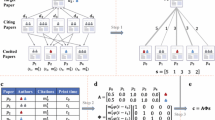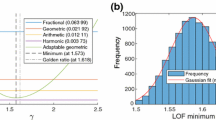Abstract
Collaboration among researchers plays an important role in scientific discoveries, especially in multidisciplinary research. How to allocate credit reasonably to coauthors of a paper is a long-standing problem in the science of sciences. The collective credit allocation method (CCA method) proposed by Shen, H. W. and Barabási, A. L. provides a novel view to solve this problem, which measures the coauthors’ contribution to a paper based on the citation process by the scientific community. Nevertheless, the existing collective allocation method assigns equal weights to citing papers, which is sensitive to the malicious manipulation. In this paper, we propose a nonlinear collective credit allocation method (NCCA method) that assigns different strength to citing papers according to papers’ scientific impact when measuring papers’ similarity. Compared to the CCA method, we find that the NCCA method assigns more credits to Nobel laureates in the Nobel-winning papers. Moreover, the NCCA method is robust against random perturbations and the malicious manipulation in both Nobel-prize papers and ordinary papers. Furthermore, the collective credit allocation method can also modify h index.







Similar content being viewed by others
References
Allen, L., Brand, A., Scott, J., Altman, M., & Hlava, M. (2014). Credit where credit is due. Nature, 508(7496), 312–313.
Ancheyta, J. (2015). A correction of h-index to account for the relative importance of authors in manuscripts. International Journal of Oil Gas and Coal Technology, 10, 221–232.
Ausloos, M. (2015). Assessing the true role of coauthors in the h-index measure of an author scientific impact. Physica A, 422, 136–142.
Bao, P., & Zhai, C. (2017). Dynamic credit allocation in scientific literature. Scientometrics, 112(1), 595–606.
Batista, P. D., Campiteli, M. G., & Kinouchi, O. (2006). Is it possible to compare researchers with different scientific interests? Scientometrics, 68(1), 179–189.
Bornmann, L., & Daniel, H. D. (2007). What do we know about the h index? Journal of the American Society for Information Science and technology, 58(9), 1381–1385.
Burrell, Q. L. (2007). Should the h-index be discounted. ISSI Newsletter, S(5), 65–68.
Crispo, E. (2015). A new index to use in conjunction with the h-index to account for an author’s relative contribution to publications with high impact. Journal of the Association for Information Science and Technology, 66, 2381–2383.
Dong, Y., Ma, H., Shen, Z., & Wang, K. (2017, August). A century of science: Globalization of scientific collaborations, citations, and innovations. In Proceedings of the 23rd ACM SIGKDD international conference on knowledge discovery and data mining (pp. 1437–1446). ACM.
Egghe, L. (2008). Mathematical theory of the h- and g-index in case of fractional counting of authorship. Journal of the American Society for Information Science and Technology, 59, 1608–1616.
Egghe, L., Rousseau, R., & Van Hooydonk, G. (2000). Methods for accrediting publications to authors or countries: Consequences for evaluation studies. Journal of the Association for Information Science and Technology, 51(2), 145–157.
Foulkes, W., & Neylon, N. (1996). Redefining authorship. Relative contribution should be given after each author’s name. BMJ: British Medical Journal, 312(7043), 1423.
Galam, S. (2011). Tailor based allocations for multiple authorship: A fractional gh-index. Scientometrics, 89, 365–379.
Garfield, E. (1972). Citation analysis as a tool in journal evaluation. Science, 178(4060), 471–479.
Greene, M. (1999). Policy on Papers’ contributors. Nature, 399(6735), 393.
Greene, M. (2007). The demise of the lone author. Nature, 450(7173), 1165.
Hagen, N. T. (2008). Harmonic allocation of authorship credit: Source-level correction of bibliometric bias assures accurate publication and citation analysis. PLoS ONE, 3(12), e4021.
Hirsch, J. E. (2005). An index to quantify an individual’s scientific research output. Proceedings of the National academy of Sciences of the United States of America, 102(46), 16569.
Hirsch, J. E. (2007). Does the h index have predictive power? Proceedings of the National Academy of Sciences, 104(49), 19193–19198.
Hirsch, J. E. (2019). h α: An index to quantify an individual’s scientific leadership. Scientometrics, 118(2), 673–686.
Kaur, J., Radicchi, F., & Menczer, F. (2013). Universality of scholarly impact metrics. Journal of Informetrics, 7(4), 924–932.
Kennedy, D. (2003). Multiple authors, multiple problems. Science, 301(5634), 733.
Kim, J., & Diesner, J. (2014). A network-based approach to coauthorship credit allocation. Scientometrics, 101(1), 587–602.
Lawrence, P. A. (2007). The mismeasurement of science. Current Biology, 17(15), R583–R585.
Lehmann, S., Jackson, A. D., & Lautrup, B. E. (2006). Measures for measures. Nature, 444(7122), 1003.
Liu, X. Z., & Fang, H. (2012). Modifying h-index by allocating credit of multi-authored papers whose author names rank based on contribution. Journal of Informetrics, 6, 557–565.
Newman, M. E. (2004). Coauthorship networks and patterns of scientific collaboration. Proceedings of the National Academy of Sciences, 101(suppl 1), 5200–5205.
Radicchi, F., Fortunato, S., Markines, B., & Vespignani, A. (2009). Diffusion of scientific credits and the ranking of scientists. Physical Review E, 80(5), 056103.
Schreiber, M. (2008a). To share the fame in a fair way, hm modifies h for multi-authored manuscripts. New Journal of Physics, 10, 040201.
Schreiber, M. (2008b). A modification of the h-index: The hm-index accounts for multi-authored manuscripts. Journal of Informetrics, 2, 211–216.
Schreiber, M. (2009). A case study of the modified Hirsch index hm accounting for multiple coauthors. Journal of the American Society for Information Science and Technology, 60, 1274–1282.
Sekercioglu, C. H. (2008). Quantifying coauthor contributions. Science, 322(5900), 371–371.
Shen, H. W., & Barabási, A. L. (2014). Collective credit allocation in science. Proceedings of the National Academy of Sciences, 111(34), 12325–12330.
Sinatra, R., Wang, D., Deville, P., Song, C., & Barabaśi, A. L. (2016). Quantifying the evolution of individual scientific impact. Science, 354(aa6312), 5239.
Stallings, J., Vance, E., Yang, J., Vannier, M. W., Liang, J., Pang, L., et al. (2013). Determining scientific impact using a collaboration index. Proceedings of the National Academy of Sciences, 110(24), 9680–9685.
Trueba, F. J., & Guerrero, H. (2004). A robust formula to credit authors for their publications. Scientometrics, 60(2), 181–204.
Tscharntke, T., Hochberg, M. E., Rand, T. A., Resh, V. H., & Krauss, J. (2007). Author sequence and credit for contributions in multiauthored publications. PLoS Biology, 5(1), e18.
Van Hooydonk, G. (1997). Fractional counting of multiauthored publications: Consequences for the impact of authors. Journal of the American Society for Information Science, 48(10), 944–945.
Vavrycuk, V. (2018). Fair ranking of researchers and research teams. PLoS ONE, 13(4), e0195509.
Wuchty, S., Jones, B. F., & Uzzi, B. (2007). The increasing dominance of teams in production of knowledge. Science, 316(5827), 1036–1039.
Zeng, A., Shen, Z., Zhou, J., Wu, J., Fan, Y., Wang, Y., et al. (2017). The science of science: From the perspective of complex systems. Physics Reports, 714, 1–73.
Acknowledgements
This work was supported by National Natural Science Foundation of China (Grant Nos. 61603046 and 61374175) and Natural Science Foundation of Beijing (Grant No. L160008).
Author information
Authors and Affiliations
Corresponding authors
Electronic supplementary material
Below is the link to the electronic supplementary material.
Rights and permissions
About this article
Cite this article
Wang, F., Fan, Y., Zeng, A. et al. A nonlinear collective credit allocation in scientific publications. Scientometrics 119, 1655–1668 (2019). https://doi.org/10.1007/s11192-019-03107-x
Received:
Published:
Issue Date:
DOI: https://doi.org/10.1007/s11192-019-03107-x




